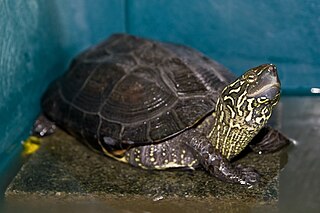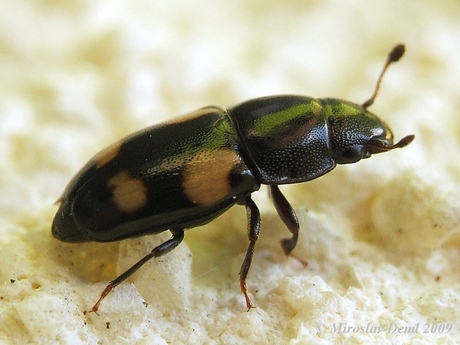Vacation feeders and “toys” for turtles…reptile care supplies certainly have come a long way since I started on my pet care and zoo-keeping career! Today I’d like to highlight two new automatic feeders designed especially for turtles (I believe both will be useful for African Clawed Frogs, Mexican Axolotls, newts and larger fishes as well). Exo Terra’s Automatic Feeder represents a great step forward in turtle care, allowing for 4 daily feedings of different foods over an extended period of time. The Zoo Med Floating Turtle Feeder, while not technically a “toy”, will keep you and your turtles entertained. Similar to behavioral enrichment tools and activities I employed at the Bronx Zoo, this feeder forces turtles to “work” for their meals, thereby encouraging activity and foraging behaviors. Read More »
Category Archives: Reptile and Amphibian Health
Feed SubscriptionReeve’s Turtle – Perfect Pet Turtles for Red Eared Slider Fans
The Reeve’s Turtle, Mauremys reevesii, (a/k/a Chinese Three-Keeled Pond Turtle, Japanese Coin Turtle, Golden Turtle) was one of the first Asian species available to aspiring herpetologists of my generation. Early-on, I found it to be as hardy, even-tempered and willing to breed as the Red-eared Slider, but easier to accommodate in, especially for one with limited space. In time, it appeared less often in the trade, and my work with rarer Asian turtles at the Bronx Zoo kept the species “off my radar” for some years. Today I’m happy to see that both new and experienced turtle fans are again keeping this fascinating denizen of East Asia’s wetlands. In my opinion, Reeve’s Turtles make better “first reptile pets” than does the slider, yet is interesting enough for the most advanced turtle-enthusiasts. Today I’ll review its care and natural history…please post your own thoughts and experiences below.
Description
Reeve’s Turtles vary from tan to black in carapace color, with many sporting a pleasing combination of several shades, and the head and neck are marked with broken yellow lines. The carapace’s 3 sharp keels lend interest to its appearance. Most top out at 5 inches in length, but I’ve seen a number of 8-9 inch long individuals. Some Japanese populations produce turtles in the 12 inch range.
Color, pattern, size and head width vary widely across the huge range. Although 1 species is recognized at present, genetic evaluation may lead to the naming of additional species or sub-species. Read More »
Poison Frogs – Sap Beetles as an Alternative Food for Small Frogs
Keepers of Poison Frogs, Mantellas, newly-transformed frogs, and other tiny amphibians face difficulties in providing their charges with a varied diet. Wild frogs consume dozens to hundreds of invertebrate species, but captives are usually limited to fruit flies, flour beetles, pinhead crickets and springtails. Vitamin/mineral supplements help, but dietary variety remains critical.
Throughout my career at the Bronx and Staten Island Zoos, I have relied heavily upon wild-caught invertebrates. I recently “re-discovered” an old favorite – the various Sap or Picnic Beetles (Family Nitidulidae). I first used Sap beetles when rearing Wood Frog metamorphs decades ago, and later fed them to Spring Peepers, Red-Eyed Treefrogs, Poison Frogs and others in zoo collections. Many small amphibians will eagerly gobble up Sap Beetles, but Poison Frog and Mantella keepers will find them especially useful. Sap Beetles never fail to bring an enthusiastic feeding response, and can save us some time and money while providing nutrients missing from standard foods.
Natural History
Sap Beetles are classified in the Family Nitidulidae, which contains nearly 3,000 members. Most top out at 1/8 inch, with the largest barely reaching ¼ inch in length. Several species, commonly known as “Picnic Beetles”, show up when sweet foods are served outdoors. Some feed upon over-ripe fruits, corn and other crops, while others take nectar, sap, fungi and carrion. Read More »
Geckos – Setting Up a Terrarium, Gecko Supplies, and Gecko Facts
Gecko fans are fortunate indeed (I included, as I’ve worked with a great many in zoos and the field)…over 150 species are available in the pet trade, many of which do quite well in modest enclosures. Among geckos we find lizards of every conceivable description – rainforest dwellers, desert specialists, burrowers, gliders, giants and many others. Today I’ll review some guidelines that will help you to set up terrariums for a variety of species. The following information can be applied to most available geckos, but details will vary. Please post below for information on individual species.
Natural History
The family Gekkonidae contains over 1,050 species. Among lizards, their diversity is exceeded only by the skinks.
Geckos may be found in deserts, rainforests, woodlands and grasslands. Some associate with people voluntarily –the aptly-named House Geckos favor our dwellings, while Tokay Geckos are established in Miami and other large cities. Five species are native to the USA, but approximately 15 have been introduced from elsewhere. Geckos range in size from the 1.2 inch-long Reef Geckos to the stout, 15 inch-long New Caledonian Giant Gecko.
The amazing ability of some geckos to run upside-down on ceilings was first recorded by Aristotle in the 4th Century. Gecko feet are being studied with a view towards creating new adhesives. Read More »
The Green Anole – Important Supplies for Anoles and other Lizard Pets
The Green or Carolina Anole, Anolis carolinensis, has introduced generations of herp enthusiasts to reptile-keeping. Small, active, and willing to breed in captivity, this handsome arboreal lizard makes a wonderful pet. Although associated with “beginners”, Green Anoles are complex creatures, well able to hold the interest of lifelong herpetologists and pet keepers, myself included. A huge array of relatives (there are over 370 anole species!), many available in the pet trade, can be kept in a similar manner. Today I’ll review supplies for Anoles and similar lizards to get you started off right. Please see the linked articles, and post questions below, for detailed information on care and breeding.
The Terrarium
Although small, Green Anoles active and require spacious terrariums; they become stressed in tight quarters. A single animal can be housed in a 15 gallon tank; pair or trio should be provided with a 20 gallon aquarium.
The Zoo Med Repti-Breeze Aluminum/Screen Cage is perhaps the best option. It provides critical air circulation and, when placed outdoors, also allows for UVB exposure (glass and plastic filter-out UVB rays).
The extra-tall Exo Terra Terrarium can also be fashioned into an excellent anole habitat.
Terrarium Furnishings
Numerous branches should be provided, along with plants and vines. Anoles will be stressed in a bare terrarium – plants provide “sight barriers” that offer security and ease aggression among tank-mates. Read More »
 That Reptile Blog – Reptile, Amphibian and Exotic Pet Care and Information
That Reptile Blog – Reptile, Amphibian and Exotic Pet Care and Information




